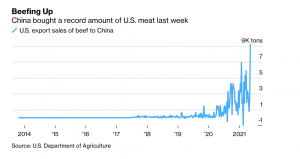Bloomberg's Leah Nylen reported Thursday that "a Colorado judge issued an order temporarily blocking the proposed $25 billion merger of Kroger Co. and Albertsons Cos., which has been challenged by…
Hog Prices Climb to Seven Year High, as Food Inflation Variables Impact Protein Prices
Bloomberg writer Michael Hirtzer reported on Friday that, “America’s insatiable appetite for ribs and hot dogs pushed hog prices to the highest in nearly seven years as the summer grilling season kicks off.

“Warm temperatures have always been a seasonal lift for meat demand but rising sales of outdoor barbecue grills during the pandemic may provide an even bigger boost this year. Plus, hog supplies are already tight from farmers culling herds last year when virus-stricken workers forced pork packers to close plants.”
Mr. Hirtzer explained that, “The combination of rising demand and limited supply has bumped up prices for some cuts: Pork spareribs are at $288.91 per 100 pounds, the highest ever. That’s helping to recoup profit margins to pork packers who were recently squeezed by the rapid escalation in hog prices that had outpaced gains in the pork market.
Meanwhile, consumers preparing for backyard barbecues are getting hit with higher prices amid rising food inflation.
And Reuters writer Mark Weinraub reported late last week that, “Chicago Mercantile Exchange hog futures rallied on Friday to their highest in nearly seven years, with strong demand outstripping supplies on hand as restaurants around the United States have been reopening after COVID-19 shutdowns, traders said.
“‘We are seeing strong retail demand, with the food service trying to recapture their share of the market,’ said Matthew Wiegand, a risk management consultant and commodity broker at FuturesOne in Nebraska. ‘But the supply has not fully rebounded as much as they would like it.'”
More narrowly with respect to protein consumption and inflation, Bloomberg writer Anne Riley Moffat reported on Friday that, “Inflation is landing in America’s refrigerators — and it’s hitting meat-eaters most of all.

“About one in three U.S. adults say they’re spending more on groceries than they were at the start of 2021, according to a Morning Consult survey of 2,200 U.S. adults conducted May 17 to 19 for Bloomberg News. Red meat was the ingredient cited most often for its higher prices, with chicken right behind.”
The Bloomberg article stated that, “Food inflation has been inching up for months, driven by soaring commodity costs, costlier transportation and challenges securing labor. Rising demand for meat, from home cooks as well as from the booming fast-food industry, has buoyed prices, too.”
Beyond those cited food inflation variables, on Friday, Bloomberg’s Michael Hirtzer reported that, “Argentina’s unorthodox beef-export ban is the latest disruption to supply chains that is forcing consumers to pay higher prices for meat.

“The South American nation halted shipments of beef for 30 days as inflation approaches 50% annually. However, Argentina supplies almost one-quarter of China’s beef imports and the ban is expected to shake up global meat markets, namely by prompting buyers in China to buy more from Brazil and the U.S.”





